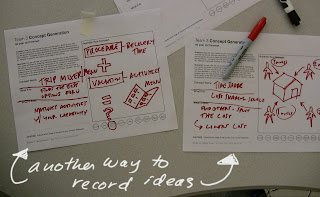If you are looking for a way to incorporate other people's opinions or ideas into your concepts or designs, a concept generation workshop can be an effective tool to employ. Here are some general thoughts to keep in mind while planning and hosting your workshop.
 What it is:
What it is:A group of people at a table (or in a room) talking about the same topic, generating and recording ideas and solutions based on personal knowledge or experience. Many times people are separated into smaller working groups (4-6 people).
What it does:Generates ideas, concepts, or connections that you haven't thought of yet.
ok, here goes.
1. Start early.People you want at your workshop have busy schedules. Pick a date two months or more in advance and get your workshop into your contacts' calendar as soon as possible.
 2. Understand the problem you're trying to solve and how your guests can help you solve it.
2. Understand the problem you're trying to solve and how your guests can help you solve it.Pretty much everything builds around this question. If you are looking for creative answers, get creative people at your workshop. If you need to develop solutions for assembly line workers, get assembly workers and/or the people who plan the lines. We had design planners at our most recent workshop, so we used them to plan out our designs. Don't assume people can play a role other than who they are (don't have 25 year olds guess what baby boomers want).
3. Moderate well. This means when your small group (4-6 people) is coming up with new crazy ideas, you may want to think about these things:
- There are no bad ideas. Any negative comment stifles creativity and shuts groups down, so every idea is encouraged and recorded. This is difficult because even giving somebody a weird look or making a small sign of disapproval can make people feel insecure about contributing. [this is also a useful method to help people recognize how critical they can be toward others--a sure way to deflate a group, or a person]
- Build off of ideas. Offer improvements or push an idea further. The wilder the better for idea generation.

- Keep the team on target. Bring them back to useful space if they're hung up or in a rut.
- Stay flexible. You might spend hours designing a structure for your workshop only to find that your participants don't need it or don't understand it. This isn't necessarily bad because your participants will most likely think about your problem in a different way than you do (why else would they be at your workshop?).
- Record every idea. Whether on a post-it, a piece of paper, or a white board, write everything down. Edit later!
4. Keep things fun and light.People tend to generate creative ideas better when they're having fun. Once things turn serious, people can become analytical and turn their creative switches off. A group brainstorm is serious business, but it should be fun and engaging. IDEO did an interesting workshop about brainstorming. They sent their team up on stage and intentionally committed all the cardinal sins of brainstorming, like answering a cell phone, shooting down ideas, not participating, and pressuring people to come up with big ideas.
Extras:
 Material:
Material:- post-its/paper
- black sharpies (can read at a distance)
- big white board
- digital camera (to capture ideas after they're generated)
- video camera/tripod (to film any presentations at the end)
Potential Timeline:- intro (5 min)
- small group intro and instructions (5 min)
- structured brainstorm (30-45 min)
- group cluster / major them discussion (30-60 min)
- present results from each group (5 min per group)
 1. Become a thought leader on your topic early in the project.
1. Become a thought leader on your topic early in the project. bvious, but when you're working on six projects exhaustive research can be rare.
bvious, but when you're working on six projects exhaustive research can be rare.


